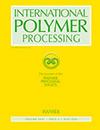聚合物-金属杂化材料在机械载荷作用下的原位泄漏行为
IF 1.9
4区 工程技术
Q4 ENGINEERING, CHEMICAL
引用次数: 0
摘要
对介质的密封性是技术部件的常用要求。尽管有各种标准化的测试程序,但在使用过程中经常发生故障。通常,事后无法确定失败的明确原因。在本文中,提出并应用了一种新的测试装置,它允许在机械负载期间进行原位测量。流量计的测量范围为0.02 mL/min至5 mL/min,用于此目的。这使得有可能确定泄漏率与时间分辨率,从而确定失效的时刻或因果失效负载。这种新方法直接应用于不同的铝镶件与聚酰胺66 (PA66)覆盖模具。结果表明,在达到最大力之前,即使有多个负载,泄漏也不会增加。这个最大力只取决于插入件的预处理,可以通过一个简单的拉出测试来确定,而不依赖于这里使用的测试装置,因此可以用于组件的设计。在测试中,未处理的刀片所承受的最大力为100 N,涂有附着力促进剂的部件所承受的最大力为140 N,接触面积为48 mm2的蚀刻刀片所承受的最大力为600 N。有了这个结果,可以显示附着力和密封性之间的新联系,当然这只适用于最初的紧密部件。本文章由计算机程序翻译,如有差异,请以英文原文为准。
In-situ leakage behavior of polymer-metal hybrids under mechanical load
Abstract Tightness against media is a frequent requirement for technical components. Despite various standardized test procedures, failure regularly occurs during use. Often, no clear cause for failure can be determined afterwards. In this article, a new test setup is presented and applied, which allows an in-situ measurement during a mechanical load. A flow meter with a measuring range of 0.02 mL/min to 5 mL/min is used for this purpose. This makes it possible to determine leakage rates with time resolution and thus to identify the moment of failure or the causal failure load. This new method was applied directly to different aluminum inserts with a polyamide 66 (PA66) overmold. It was shown that no increase in leakage occurs until a maximum force is reached, even with multiple loads. This maximum force depends only on the pretreatment of the inserts and can be determined in a simple pull-out test independently of the test setup used here and can therefore be used for the design of assemblies. In the test, a maximum force of 100 N was achieved for untreated inserts, 140 N for adhesion promoter-coated parts and 600 N for etched inserts with a contact area of 48 mm2. With this results, a new link between adhesion and tightness can be shown, which of course is only valid for initial tight parts.
求助全文
通过发布文献求助,成功后即可免费获取论文全文。
去求助
来源期刊

International Polymer Processing
工程技术-高分子科学
CiteScore
2.20
自引率
7.70%
发文量
62
审稿时长
6 months
期刊介绍:
International Polymer Processing offers original research contributions, invited review papers and recent technological developments in processing thermoplastics, thermosets, elastomers and fibers as well as polymer reaction engineering. For more than 25 years International Polymer Processing, the journal of the Polymer Processing Society, provides strictly peer-reviewed, high-quality articles and rapid communications from the leading experts around the world.
 求助内容:
求助内容: 应助结果提醒方式:
应助结果提醒方式:


